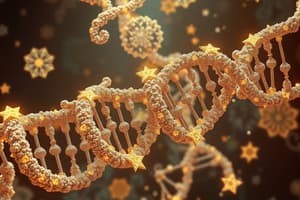Podcast
Questions and Answers
Where does transcription take place in a cell?
Where does transcription take place in a cell?
- Endoplasmic Reticulum
- Mitochondria
- Nucleus (correct)
- Cytoplasm
Which enzyme is responsible for catalyzing the synthesis of RNA from DNA templates?
Which enzyme is responsible for catalyzing the synthesis of RNA from DNA templates?
- RNA Polymerase (correct)
- DNA Polymerase
- RNA Helicase
- Ligase
Where does translation occur within a cell?
Where does translation occur within a cell?
- Nucleus
- Mitochondria
- Lysosome
- Ribosomes (correct)
Which component of ribosomes is responsible for decoding the genetic code within mRNA?
Which component of ribosomes is responsible for decoding the genetic code within mRNA?
What do ribosomes use to assemble amino acids according to the instructions from mRNA?
What do ribosomes use to assemble amino acids according to the instructions from mRNA?
Flashcards are hidden until you start studying
Study Notes
Protein Synthesis
Protein synthesis is the process by which cells create proteins, essential molecules involved in cell structure, immune responses, and other critical functions. This process occurs through two main steps: transcription and translation.
Transcription
Transcription is the first step of protein synthesis, where genetic information stored within DNA is copied into messenger RNA (mRNA). This is accomplished in the nucleus of the cell using enzymes known as RNA polymerases. The strand complementary to the template DNA strand forms the mature mRNA.
RNA Polymerase
RNA polymerase is a complex enzyme responsible for catalyzing the synthesis of RNA from DNA templates. It has several different subunits depending on whether it's producing mRNA (α,β,γ) or tRNA (α,δ,ε) or rRNA (α,ε,β).
Translation
Translation is the second step of protein synthesis, occurring outside the nucleus in cytoplasmic structures called ribosomes. Here, the genetic code contained within mRNA is decoded and used to build a specific sequence of amino acids known as a polypeptide chain.
Ribosomes
Ribosomes are large macromolecular complexes found in all living organisms, composed of ribosomal RNA (rRNA) and ribosomal proteins. They serve as the site of protein biosynthesis, assembling amino acids according to instructions encoded in a message carried by transfer RNAs (tRNAs) and mRNA.
Transfer RNA (tRNA)
Transfer RNA (tRNA) carries individual amino acids to the growing polypeptide chain during translation. There are 20 different types of tRNAs, each specifically recognized by a unique anticodon base sequence on the tRNA.
Amino Acids
Amino acids are the building blocks of proteins, linked together via peptide bonds between their carboxyl and amino groups. There are 20 common amino acids commonly found in proteins, which can be classified based on their chemical properties, such as polarity and charge.
Studying That Suits You
Use AI to generate personalized quizzes and flashcards to suit your learning preferences.




